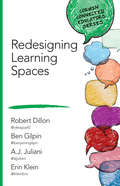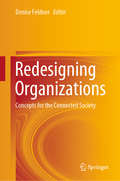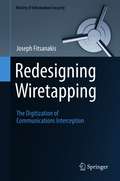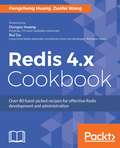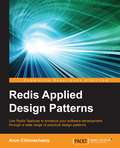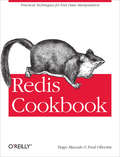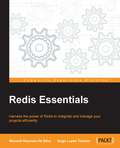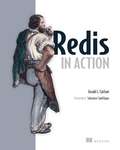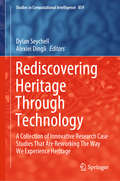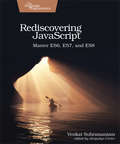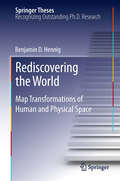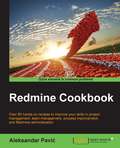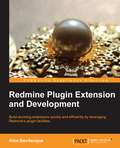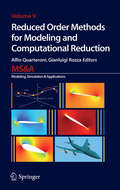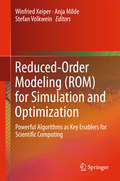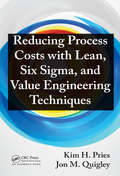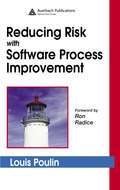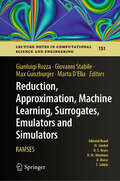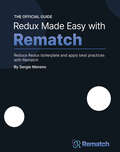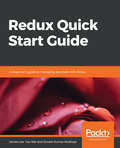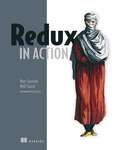- Table View
- List View
Redesigning Learning Spaces (Corwin Connected Educators Series)
by Benjamin D. Gilpin Erin M. Klein Robert W. Dillon A. J. JulianiIt is time for the desks to lose and the children to win Bring hope, joy, and positive energy back into the daily work of the classroom. Explore how learning space design can positively impact classroom learning, the culture of a school, healthy communities, and systems and structures that make education meaningful. In this book you’ll: Find resources for redesigning spaces on a sustainable budget Support technology integration through b¬¬lended and virtual learning Hear success stories from the field The Corwin Connected Educators series is your key to unlocking the greatest resource available to all educators: other educators. Being a Connected Educator is more than a set of actions; it’s a belief in the potential of technology to fuel lifelong learning. "Redesigning Learning Spaces will take you beyond the standard classroom with ideas for creating spaces that sizzle with excitement and glow with beauty and grace." —Daniel H. Pink, author of Drive and A Whole New Mind "As a son of teachers, as a parent, and as a technologist, I recommend this book for educators who want to create a better learning experience for our children." —Gary Shapiro, author of Ninja Innovation and The Comeback
Redesigning Learning Spaces (Corwin Connected Educators Series)
by Benjamin D. Gilpin Erin M. Klein Robert W. Dillon A. J. JulianiIt is time for the desks to lose and the children to win Bring hope, joy, and positive energy back into the daily work of the classroom. Explore how learning space design can positively impact classroom learning, the culture of a school, healthy communities, and systems and structures that make education meaningful. In this book you’ll: Find resources for redesigning spaces on a sustainable budget Support technology integration through b¬¬lended and virtual learning Hear success stories from the field The Corwin Connected Educators series is your key to unlocking the greatest resource available to all educators: other educators. Being a Connected Educator is more than a set of actions; it’s a belief in the potential of technology to fuel lifelong learning. "Redesigning Learning Spaces will take you beyond the standard classroom with ideas for creating spaces that sizzle with excitement and glow with beauty and grace." —Daniel H. Pink, author of Drive and A Whole New Mind "As a son of teachers, as a parent, and as a technologist, I recommend this book for educators who want to create a better learning experience for our children." —Gary Shapiro, author of Ninja Innovation and The Comeback
Redesigning Organizations: Concepts for the Connected Society
by Denise FeldnerThis book offers readers a deeper understanding of the Cyberspace, of how institutions and industries are reinventing themselves, helping them excel in the transition to a fully digitally connected global economy. Though technology plays a key part in this regard, societal acceptance is the most important underlying condition, as it poses pressing challenges that cut across companies, developers, governments and workers. The book explores the challenges and opportunities involved, current and potential future concepts, critical reflections and best practices. It addresses connected societies, new opportunities for governments, the role of trust in digital networks, and future education networks. In turn, a number of representative case studies demonstrate the current state of development in practice.
Redesigning Wiretapping: The Digitization of Communications Interception (History of Information Security)
by Joseph FitsanakisThis book tells the story of government-sponsored wiretapping in Britain and the United States from the rise of telephony in the 1870s until the terrorist attacks of 9/11.It pays particular attention to the 1990s, which marked one of the most dramatic turns in the history of telecommunications interception. During that time, fiber optic and satellite networks rapidly replaced the copper-based analogue telephone system that had remained virtually unchanged since the 1870s. That remarkable technological advance facilitated the rise of the networked home computer, cellular telephony, and the Internet, and users hailed the dawn of the digital information age. However, security agencies such as the FBI and MI5 were concerned. Since the emergence of telegraphy in the 1830s, security services could intercept private messages using wiretaps, and this was facilitated by some of the world's largest telecommunications monopolies such as AT&T in the US and British Telecom in the UK. The new, digital networks were incompatible with traditional wiretap technology. To make things more complicated for the security services, these monopolies had been privatized and broken up into smaller companies during the 1980s, and in the new deregulated landscape the agencies had to seek assistance from thousands of startup companies that were often unwilling to help. So for the first time in history, technological and institutional changes posed a threat to the security services’ wiretapping activities, and government officials in Washington and London acted quickly to protect their ability to spy, they sought to force the industry to change the very architecture of the digital telecommunications network.This book describes in detail the tense negotiations between governments, the telecommunications industry, and civil liberties groups during an unprecedented moment in history when the above security agencies were unable to wiretap. It reveals for the first time the thoughts of some of the protagonists in these crucial negotiations, and explains why their outcome may have forever altered the trajectory of our information society.
Redis 4.x Cookbook: Over 80 hand-picked recipes for effective Redis development and administration
by Pengcheng Huang Zuofei WangLeverage the power of Redis 4.x to develop, optimize and administer your Redis solutions with ease Key Features Build, deploy and administer high performance and scalable applications in Redis Covers a range of important tasks - including development and administration of Redis A practical guide that takes your understanding of Redis to the next level Book Description Redis is considered the world's most popular key-value store database. Its versatility and the wide variety of use cases it enables have made it a popular choice of database for many enterprises. Based on the latest version of Redis, this book provides both step-by-step recipes and relevant the background information required to utilize its features to the fullest. It covers everything from a basic understanding of Redis data types to advanced aspects of Redis high availability, clustering, administration, and troubleshooting. This book will be your great companion to master all aspects of Redis. The book starts off by installing and configuring Redis for you to get started with ease. Moving on, all the data types and features of Redis are introduced in detail. Next, you will learn how to develop applications with Redis in Java, Python, and the Spring Boot web framework. You will also learn replication tasks, which will help you to troubleshoot replication issues. Furthermore, you will learn the steps that need to be undertaken to ensure high availability on your cluster and during production deployment. Toward the end of the book, you will learn the topmost tasks that will help you to troubleshoot your ecosystem efficiently, along with extending Redis by using different modules. What you will learn Install and configure your Redis instance Explore various data types and commands in Redis Build client-side applications as well as a Big Data framework with Redis Manage data replication and persistence in Redis Implement high availability and data sharding in Redis Extend Redis with Redis Module Benchmark, debug, fine-tune and troubleshoot various issues in RedisWho this book is for This book is for database administrators, developers and architects who want to tackle the common and not so common problems associated with the different development and administration-related tasks in Redis. A fundamental understanding of Redis is expected to get the best out of this book.
Redis Applied Design Patterns
by Arun ChinnachamyWith new data stores making their way onto the market, it's necessary for businesses to understand the features and techniques to use data stores most effectively. Redis Applied Design Patterns is designed to guide you into the world of Redis and will help you understand how business problems can be solved using Redis in your application stack. This book introduces you to the NoSQL way of thinking and how it is different from SQL. It helps you understand various functionality of Redis through a series of use cases designed for you to learn the more complex and less well-known features of Redis in an incremental way. By the time you've read this book, you will be capable of designing a system using Redis. This book will guide you through various use cases along with code samples, easy-to-understand diagrams, and tips to help you take advantage of Redis. The book explains the benefits of adding Redis to the application stack and discusses various practical use cases for Redis such as the caching system, commenting system, and social networking.
Redis Cookbook: Practical Techniques for Fast Data Manipulation
by Tiago Macedo Fred OliveiraTwo years since its initial release, Redis already has an impressive list of adopters, including Engine Yard, GitHub, Craigslist, and Digg. This open source data structure server is built for speed and flexibility, making it ideal for many applications. If you're using Redis, or considering it, this concise cookbook provides recipes for a variety of issues you're likely to face.Each recipe solves a specific problem, and provides an in-depth discussion of how the solution works. You’ll discover that Redis, while simple in nature, offers extensive functionality for manipulating and storing data.Learn when it makes sense to use RedisExplore several methods for installing RedisConnect to Redis in a number of ways, ranging from the command line to popular languages such as Python and RubySolve a range of needs, from linked datasets to analyticsHandle backups, sharding, datasets larger than available memory, and many other tasks
Redis Essentials
by Maxwell Dayvson Silva Hugo Lopes TavaresHarness the power of Redis to integrate and manage your projects efficiently About This Book * Learn how to use Redis's data types efficiently to manage large data sets * Scale Redis to multiple servers with Twemproxy, Redis Sentinel, and Redis Cluster * A fast-paced guide, full of real-world examples to help you get the best out of the features offered by Redis Who This Book Is For If you are a competent developer with experience of working with data structure servers and want to boost your project's performance by learning about features of Redis, then this book is for you. What You Will Learn * Build analytics applications using Bitmaps and Hyperloglogs * Enhance scalability with Twemproxy, Redis Sentinel, and Redis Cluster * Build a Time Series implementation in Node.js and Redis * Create your own Redis commands by extending Redis with Lua * Get to know security techniques to protect your data (SSL encryption, firewall rules, basic authorization) * Persist data to disk and learn the trade-offs of AOF and RDB * Understand how to use Node.js, PHP, Python, and Ruby clients for Redis * Avoid common pitfalls when designing your next solution In Detail Redis is the most popular in-memory key-value data store. It's very lightweight and its data types give it an edge over the other competitors. If you need an in-memory database or a high-performance cache system that is simple to use and highly scalable, Redis is what you need. Redis Essentials is a fast-paced guide that teaches the fundamentals on data types, explains how to manage data through commands, and shares experiences from big players in the industry. We start off by explaining the basics of Redis followed by the various data types such as Strings, hashes, lists, and more. Next, Common pitfalls for various scenarios are described, followed by solutions to ensure you do not fall into common traps. After this, major differences between client implementations in PHP, Python, and Ruby are presented. Next, you will learn how to extend Redis with Lua, get to know security techniques such as basic authorization, firewall rules, and SSL encryption, and discover how to use Twemproxy, Redis Sentinel, and Redis Cluster to scale infrastructures horizontally. At the end of this book, you will be able to utilize all the essential features of Redis to optimize your project's performance. Style and approach A practical guide that offers the foundation upon which you can begin to understand the capabilities of Redis using a step-by-step approach. This book is full of real-world problems and in-depth knowledge of the concepts and features of Redis, with plenty of examples.
Redis in Action
by Josiah CarlsonSummaryRedis in Action introduces Redis and walks you through examples that demonstrate how to use it effectively. You'll begin by getting Redis set up properly and then exploring the key-value model. Then, you'll dive into real use cases including simple caching, distributed ad targeting, and more. You'll learn how to scale Redis from small jobs to massive datasets. Experienced developers will appreciate chapters on clustering and internal scripting to make Redis easier to use.About the TechnologyWhen you need near-real-time access to a fast-moving data stream, key-value stores like Redis are the way to go. Redis expands on the key-value pattern by accepting a wide variety of data types, including hashes, strings, lists, and other structures. It provides lightning-fast operations on in-memory datasets, and also makes it easy to persist to disk on the fly. Plus, it's free and open source.About this bookRedis in Action introduces Redis and the key-value model. You'll quickly dive into real use cases including simple caching, distributed ad targeting, and more. You'll learn how to scale Redis from small jobs to massive datasets and discover how to integrate with traditional RDBMS or other NoSQL stores. Experienced developers will appreciate the in-depth chapters on clustering and internal scripting.Written for developers familiar with database concepts. No prior exposure to NoSQL database concepts nor to Redis itself is required. Appropriate for systems administrators comfortable with programming.Purchase of the print book includes a free eBook in PDF, Kindle, and ePub formats from Manning Publications.What's InsideRedis from the ground upPreprocessing real-time dataManaging in-memory datasetsPub/sub and configurationPersisting to diskAbout the AuthorDr. Josiah L. Carlson is a seasoned database professional and an active contributor to the Redis community.Table of ContentsPART 1 GETTING STARTEDGetting to know RedisAnatomy of a Redis web applicationPART 2 CORE CONCEPTSCommands in RedisKeeping data safe and ensuring performanceUsing Redis for application supportApplication components in RedisSearch-based applicationsBuilding a simple social networkPART 3 NEXT STEPSReducing memory useScaling RedisScripting Redis with Lua
Rediscovering Heritage Through Technology: A Collection of Innovative Research Case Studies That Are Reworking The Way We Experience Heritage (Studies in Computational Intelligence #859)
by Dylan Seychell Alexiei DingliWith the proliferation of technology, science became a medium used to create and interpret heritage in a way that redefines human achievements. The recent advances in technology are providing us with a variety of tools aimed at exploring, experiencing and interacting with heritage in a completely new way, which was unimaginable up until a few decades ago. Suddenly, heritage has become accessible and exciting to those who might not have previously considered it interesting. This book presents a selection of approaches in various topics such as artificial intelligence, gamification, and virtual and augmented reality, and uses practical examples to show how they can be deployed in real-world scenarios. As such, it inspires a wide variety of stakeholders and helps them experience our common heritage through a new lens.
Rediscovering JavaScript: Master ES6, ES7, and ES8
by Venkat SubramaniamJavaScript is no longer to be feared or loathed - the world's most popular and ubiquitous language has evolved into a respectable language. Whether you're writing frontend applications or server side code, the phenomenal features from ES6 and beyond - like the rest operator, generators, destructuring, object literals, arrow functions, modern classes, promises, async, and metaprogramming capabilities - will get you excited and eager to program with JavaScript. You've found the right book to get started quickly and dive deep into the essence of modern JavaScript. Learn practical tips to apply the elegant parts of the language and the gotchas to avoid. JavaScript is a black swan that no one, including the author of the language, thought would become a popular and ubiquitous language. Not long ago, it was the most hated and feared language you could use to program the web. JavaScript ES6 and beyond has gone through a significant makeover. Troublesome features have been replaced with better, elegant, more reliable alternatives. This book includes many practical examples and exercises to help you learn in depth. It will not bore you with idiosyncrasies and arcane details intended for bad interview questions. Instead, it takes you into key features that you can readily use in your day-to-day projects. Whether you program the frontend or the server side, you can now write concise, elegant, and expressive JavaScript with newer features like default parameters, template literals, rest and spread operators, destructuring, arrow functions, and generators. Take it up a notch with features like infinite series, promises, async, and metaprogramming to create flexible, powerful, and extensible libraries. While the evolved features of the language will draw you in, the hundreds of examples in this book will pin the concepts down, for you to use on your projects. Take command of modern JavaScript and unlock your potential to create powerful applications. What You Need: To try out the examples in the book you will need a computer with Node.js, a text editor, and a browser like Chrome installed in it.
Rediscovering the World
by Benjamin Hennig'We need new maps' is the central claim made in this book. In a world increasingly influenced by human action and interaction, we still rely heavily on mapping techniques that were invented to discover unknown places and explore our physical environment. Although the traditional concept of a map is currently being revived in digital environments, the underlying mapping approaches are not capable of making the complexity of human-environment relationships fully comprehensible. Starting from how people can be put on the map in new ways, this book outlines the development of a novel technique that stretches a map according to quantitative data, such as population. The new maps are called gridded cartograms as the method is based on a grid onto which a density-equalising cartogram technique is applied. The underlying grid ensures the preservation of an accurate geographic reference to the real world. It allows the gridded cartograms to be used as basemaps onto which other information can be mapped. This applies to any geographic information from the human and physical environment. As demonstrated through the examples presented in this book, the new maps are not limited to showing population as a defining element for the transformation, but can show any quantitative geospatial data, such as wealth, rainfall, or even the environmental conditions of the oceans. The new maps also work at various scales, from a global perspective down to the scale of urban environments. The gridded cartogram technique is proposed as a new global and local map projection that is a viable and versatile alternative to other conventional map projections. The maps based on this technique open up a wide range of potential new applications to rediscover the diverse geographies of the world. They have the potential to allow us to gain new perspectives through detailed cartographic depictions.
Redmine Cookbook
by Aleksandar PavicOver 80 hands-on recipes to improve your skills in project management, team management, process improvement, and Redmine administration About This Book * Efficiently install and customize Redmine for your own infrastructure, whether that be Microsoft or open source * Manage multiple projects with multiple teams across the globe in a standardized and effective way * Customize Redmine to fit your organisation's specific and unique needs Who This Book Is For This book is for those who working in management or administrator positions who are already using Redmine or are willing to start using it for project management, tracking, collaboration, or process management. Additionally, individual developers or teams can benefit from recipes related to code repositories, bug tracking, and software project management. What You Will Learn * Make Redmine run on Microsoft SQL Server with IIS * Enjoy the benefits of updating the code on a real-time basis and maintaining consistency * Manage multiple projects and teams simultaneously * Leverage Redmine features to enhance team's performance * Use Redmine for SCRUM and Agile methodologies * Deploy Redmine for Service Desk * Customize the user experience by manually tracking the ongoing projects * Extend Redmine through various plugins In Detail In a variety of online project management tools, Redmine markets itself as offering flexibility. Choosing the right management tool can mean the difference between the success and failure of a project. Flexible project management tools bend themselves to fit your needs, whether that's communication regarding a simple project, or collaboration, or more complex project methodology such as SCRUM, or an issue-code relationship, or the need of different methodology for your project. Whether you are project manager or system administrator, this book provides valuable recipes to get the best possible performance out of your team, organization, infrastructure, and Redmine itself. Through a series of carefully crafted recipes covering the nitty-gritty of Redmine, you'll be guided through the installation of Redmine, as well as how to fine-tune and customize your Redmine installation. Finally, we walk you through integrating Redmine with other softwares and databases like Tortoise SVN and Visual Studio and troubleshooting Redmine. Style and approach This book follows a step-by-step recipe-based approach. Detailed prerequisites make each recipe easy to follow and apply in practice in any kind of live environment.
Redmine Plugin Extension and Development
by Alex BevilacquaThis book provides a thorough look at the tools available within Redmine to facilitate the development of plugins and extensions. Full of tips and tricks, a recurring case study is also used to help guide you through the various content area extensions and plugin helpers and to provide context and real-world examples of the concepts being covered. This book is intended for those who want to build custom functionality into the Redmine project management platform. If you're already comfortable with Ruby, Rails, and Redmine, but you aren't quite sure what to do next, this book will walk you through the basics of getting a plugin written and integrated into various key areas of Redmine.
Reduced Order Methods for Modeling and Computational Reduction
by Gianluigi Rozza Alfio QuarteroniThis monograph addresses the state of the art of reduced order methods for modeling and computational reduction of complex parametrized systems, governed by ordinary and/or partial differential equations, with a special emphasis on real time computing techniques and applications in computational mechanics, bioengineering and computer graphics. Several topics are covered, including: design, optimization, and control theory in real-time with applications in engineering; data assimilation, geometry registration, and parameter estimation with special attention to real-time computing in biomedical engineering and computational physics; real-time visualization of physics-based simulations in computer science; the treatment of high-dimensional problems in state space, physical space, or parameter space; the interactions between different model reduction and dimensionality reduction approaches; the development of general error estimation frameworks which take into account both model and discretization effects. This book is primarily addressed to computational scientists interested in computational reduction techniques for large scale differential problems.
Reduced-Order Modeling (ROM) for Simulation and Optimization
by Winfried Keiper Anja Milde Stefan VolkweinThis edited monograph collects research contributions and addresses the advancement of efficient numerical procedures in the area of model order reduction (MOR) for simulation, optimization and control. The topical scope includes, but is not limited to, new out-of-the-box algorithmic solutions for scientific computing, e.g. reduced basis methods for industrial problems and MOR approaches for electrochemical processes. The target audience comprises research experts and practitioners in the field of simulation, optimization and control, but the book may also be beneficial for graduate students alike.
Reducing Process Costs with Lean, Six Sigma, and Value Engineering Techniques
by Jon M. Quigley Kim H. PriesA company with effective cost reduction activities in place will be better positioned to adapt to shifting economic conditions. In fact, it can make the difference between organizations that thrive and those that simply survive during times of economic uncertainty. Reducing Process Costs with Lean, Six Sigma, and Value Engineering Techniques covers
Reducing Risk with Software Process Improvement
by Louis PoulinReducing Risk with Software Process Improvement recommends the critical practices that aid in the successful delivery of software products and services. The author describes the observations that he made over a period of ten years in IT projects and organizations. He focuses on the areas of software development and maintenance, highlighting the mos
Reduction, Approximation, Machine Learning, Surrogates, Emulators and Simulators: RAMSES (Lecture Notes in Computational Science and Engineering #151)
by Gianluigi Rozza Max Gunzburger Marta D'Elia Giovanni StabileThis volume is focused on the review of recent algorithmic and mathematical advances and the development of new research directions for Mathematical Model Approximations via RAMSES (Reduced order models, Approximation theory, Machine learning, Surrogates, Emulators, Simulators) in the setting of parametrized partial differential equations also with sparse and noisy data in high-dimensional parameter spaces. The book is a valuable resource for researchers, as well as masters and Ph.D students.
Reductive Reading: A Syntax of Victorian Moralizing
by Sarah AllisonHow practices from the digital analysis of texts both simplify and enhance traditional literary criticism.Honorable Mention, NAVSA Best Book of the Year by the North American Victorian Studies AssociationWhat is to be gained by reading George Eliot’s Middlemarch from an Excel spreadsheet, or the novels of Charles Dickens through a few hundred dialogue tags—those he said/she saids that bring his characters to life? Sarah Danielle Allison’s Reductive Reading argues that the greatest gift the computational analysis of texts has given to traditional criticism is not computational at all. Rather, one of the most powerful ways to generate subtle reading is to be reductive; that is, to approach literary works with specific questions and a clear roadmap of how to look for the answers. Allison examines how patterns that form little part of our conscious experience of reading nevertheless structure our experience of books. Exploring Victorian moralizing at the level of the grammatical clause, she also reveals how linguistic patterns comment on the story in the process of narrating it. Delving into The London Quarterly Review, as well as the work of Eliot, Dickens, Elizabeth Barrett Browning, Anthony Trollope, William Makepeace Thackeray, and other canonical Victorian writers, the book models how to study nebulous and complex stylistic effects. A manifesto for and a model of how digital analysis can provide daringly simple approaches to complex literary problems, Reductive Reading introduces a counterintuitive computational perspective to debates about the value of fiction and the ethical representation of people in literature.
Reductive Reading: A Syntax of Victorian Moralizing
by Sarah Allison“A masterful integration of digital humanistic approaches and more traditional close-reading methods . . . compelling, persuasive.” —Victorian Studies for the 21st CenturyWhat is to be gained by reading George Eliot’s Middlemarch from an Excel spreadsheet, or the novels of Charles Dickens through a few hundred dialogue tags—those he said/she saids that bring his characters to life? Sarah Danielle Allison’s Reductive Reading argues that the greatest gift the computational analysis of texts has given to traditional criticism is not computational at all. Rather, one of the most powerful ways to generate subtle reading is to be reductive; that is, to approach literary works with specific questions and a clear roadmap of how to look for the answers.Allison examines how patterns that form little part of our conscious experience of reading nevertheless structure our experience of books. Exploring Victorian moralizing at the level of the grammatical clause, she also reveals how linguistic patterns comment on the story in the process of narrating it. Delving into The London Quarterly Review, as well as the work of Eliot, Dickens, Elizabeth Barrett Browning, Anthony Trollope, William Makepeace Thackeray, and other canonical Victorian writers, the book models how to study nebulous and complex stylistic effects.A manifesto for and a model of how digital analysis can provide daringly simple approaches to complex literary problems, Reductive Reading introduces a counterintuitive computational perspective to debates about the value of fiction and the ethical representation of people in literature.“A book that promises to transform the way we read novels.” —Elsie B. Michie, author of The Vulgar Question of Money
Redux Made Easy with Rematch: Reduce Redux boilerplate and apply best practices with Rematch
by Sergio MorenoDiscover the power of Rematch and its plugins by building a real-world application from scratchKey FeaturesGet to grips with the capabilities of Rematch quickly as you build applicationsLearn to use Rematch and its plugins to simplify everyday tasksTake total control of the application state and manage its scalability using RematchBook DescriptionRematch is Redux best practices without the boilerplate. This book is an easy-to-read guide for anyone who wants to get started with Redux, and for those who are already using it and want to improve their codebase.Complete with hands-on tutorials, projects, and self-assessment questions, this easy-to-follow guide will take you from the simplest through to the most complex layers of Rematch. You'll learn how to migrate from Redux, and write plugins to set up a fully tested store by integrating it with vanilla JavaScript, React, and React Native. You'll then build a real-world application from scratch with the power of Rematch and its plugins. As you advance, you'll see how plugins extend Rematch functionalities, understanding how they work and help to create a maintainable project. Finally, you'll analyze the future of Rematch and how the frontend ecosystem is becoming easier to use and maintain with alternatives to Redux.By the end of this book, you'll be able to have total control of the application state and use Rematch to manage its scalability with simplicity.What you will learnUnderstand the principal concepts of Flux and ReduxFind out what the main problems are that Rematch solvesBecome familiar with the Rematch ecosystemDevelop an application using Rematch and React togetherWrite unit and integration tests to get 100% test coverage of your programs with RematchCreate a React Native app with Rematch and ExpoPersist data with redux-persist and RematchBuild a Rematch plugin from scratchWho this book is forThis book is for React and Redux users looking for better alternatives for Redux. Familiarity with JavaScript, React, and Redux will help you make the most of this book.
Redux Quick Start Guide: A beginner's guide to managing app state with Redux
by James Lee Tao Wei Suresh Kumar MukhiyaIntegrate Redux with React and other front-end JavaScript frameworks efficiently and manage application states effectivelyKey FeaturesGet better at building web applications with state management using ReduxLearn the fundamentals of Redux to structure your app more efficientlyThis guide will teach you develop complex apps that would be easier to maintainBook DescriptionStarting with a detailed overview of Redux, we will follow the test-driven development (TDD) approach to develop single-page applications. We will set up JEST for testing and use JEST to test React, Redux, Redux-Sage, Reducers, and other components. We will then add important middleware and set up immutableJS in our application. We will use common data structures such as Map, List, Set, and OrderedList from the immutableJS framework. We will then add user interfaces using ReactJS, Redux-Form, and Ant Design.We will explore the use of react-router-dom and its functions. We will create a list of routes that we will need in order to create our application, and explore routing on the server site and create the required routes for our application. We will then debug our application and integrate Redux Dev tools.We will then set up our API server and create the API required for our application. We will dive into a modern approach to structuring our server site components in terms of Model, Controller, Helper functions, and utilities functions. We will explore the use of NodeJS with Express to build the REST API components. Finally, we will venture into the possibilities of extending the application for further research, including deployment and optimization.What you will learnFollow the test-driven development (TDD) approach to develop a single-page applicationAdd important middleware, such as Redux store middleware, redux-saga middleware, and language middleware, to your applicationUnderstand how to use immutableJS in your applicationBuild interactive components using ReactJSConfigure react-router-redux and explore the differences between react-router-dom and react-router-reduxUse Redux Dev tools to debug your applicationSet up our API server and create the API required for our applicationWho this book is forThis book is meant for JavaScript developers interesting in learning state management and building easy to maintain web applications.
Redux in Action
by Marc Garreau will faurotSummaryWith Redux in Action, you'll discover how to integrate Redux into your React application and development environment. With the insights you glean from the experience of authors Marc Garreau and Will Faurot, you'll be more than confident in your ability to solve your state management woes with Redux and focus on developing the apps you need!Foreword by Mark Erikson, Redux co-maintainer.Purchase of the print book includes a free eBook in PDF, Kindle, and ePub formats from Manning Publications.About the TechnologyWith Redux, you manage the state of a web application in a single, simple object, practically eliminating most state-related bugs. Centralizing state with Redux makes it possible to quickly start saved user sessions, maintain a reliable state history, and smoothly transfer state between UIs. Plus, the Redux state container is fully programmable and integrates cleanly with React and other popular frameworks.About the BookRedux in Action is an accessible guide to effectively managing state in web applications. Built around common use cases, this practical book starts with a simple task-management application built in React. You'll use the app to learn the Redux workflow, handle asynchronous actions, and get your hands on the Redux developer tools. With each step, you'll discover more about Redux and the benefits of centralized state management. The book progresses to more-complex examples, including writing middleware for analytics, time travel debugging, and an overview of how Redux works with other frameworks such as Angular and Electron. What's InsideUsing Redux in an existing React applicationHandling side effects with the redux-saga libraryConsuming APIs with asynchronous actionsUnit testing a React and Redux applicationAbout the ReaderFor web developers comfortable with JavaScript and React.About the AuthorMarc Garreau has architected and executed half a dozen unique client-side applications using Redux. Will Faurot is a mentor for Redux developers of all skill levels.Table of ContentsIntroducing Redux Your first Redux application Debugging Redux applications Consuming an API Middleware Handling complex side effects Preparing data for components Structuring a Redux store Testing Redux applications Performance Structuring Redux code Redux beyond React
Reel Success: Creating Demo Reels and Animation Portfolios
by Cheryl CabreraAre you an animator looking to get your foot in the door to the top studios? It's tough if you don't have a demo reel and portfolio that reflects your unique style and incredible talents. The reception of that reel will make or break you; so it's no wonder that creating a demo reel can be such a daunting task. Reel Success by Cheryl Cabrera can help. This book guides you into putting the right content into your portfolio, how to cater to the right audience, and how to harness the power of social media and network effectively. Accompanied by case studies of actual students' demo reels, this book teaches how to develop a critical eye toward effective and ineffective demo reels. Looking to get your foot in the door? Break it down with Reel Success.
